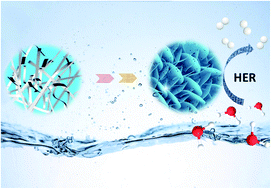Synergistically coupling ultrasmall PtCu nanoalloys with highly porous CoP nanosheets as an enhanced electrocatalyst for electrochemical hydrogen evolution†
Abstract
Platinum (Pt) is recognized as one of the most effective catalysts for the hydrogen evolution reaction (HER), but its large-scale application still suffers from high cost and unsatisfactory performance in alkaline solution. Herein, by properly integrating an ultralow amount of Pt with earth-abundant elements, we report a facile dealloying–oxidation–phosphidation method for synthesizing a PtCu nanocluster decorated CoP nanosheet electrocatalyst (PtCu/CoP) with an ultralow Pt loading (2.8 μg cm−2). With only 1/40 Pt loading of commercial 20% Pt/C, the as-prepared PtCu/CoP catalyst outperforms the Pt/C catalyst, requiring an overpotential as low as 20 mV to reach a current density of 10 mA cm−2, and showing a smaller Tafel slope of 28 mV dec−1 in 0.5 M H2SO4. In 1.0 M KOH, the PtCu/CoP catalyst also shows a superior performance to that of Pt/C, with an overpotential of 40 mV (10 mA cm−2) and a Tafel slope of 49 mV dec−1. Moreover, the PtCu/CoP catalyst can be continuously operated for 100 h in both acidic and alkaline media, with only insignificant degradation. This work provides an efficient strategy for designing a high performance HER electrocatalyst with ultralow Pt loadings.



 Please wait while we load your content...
Please wait while we load your content...